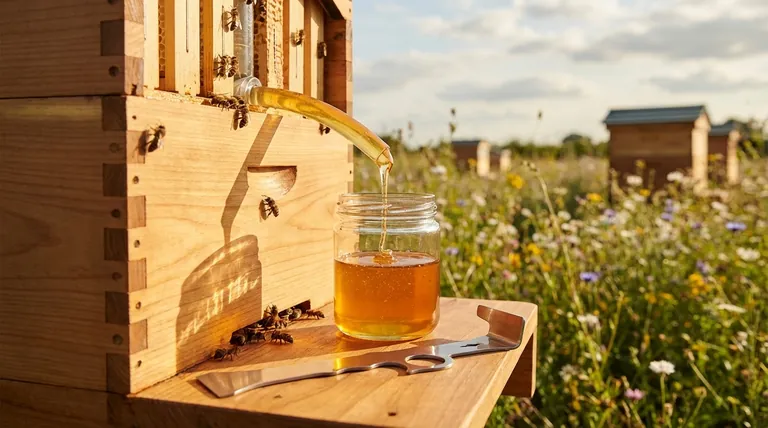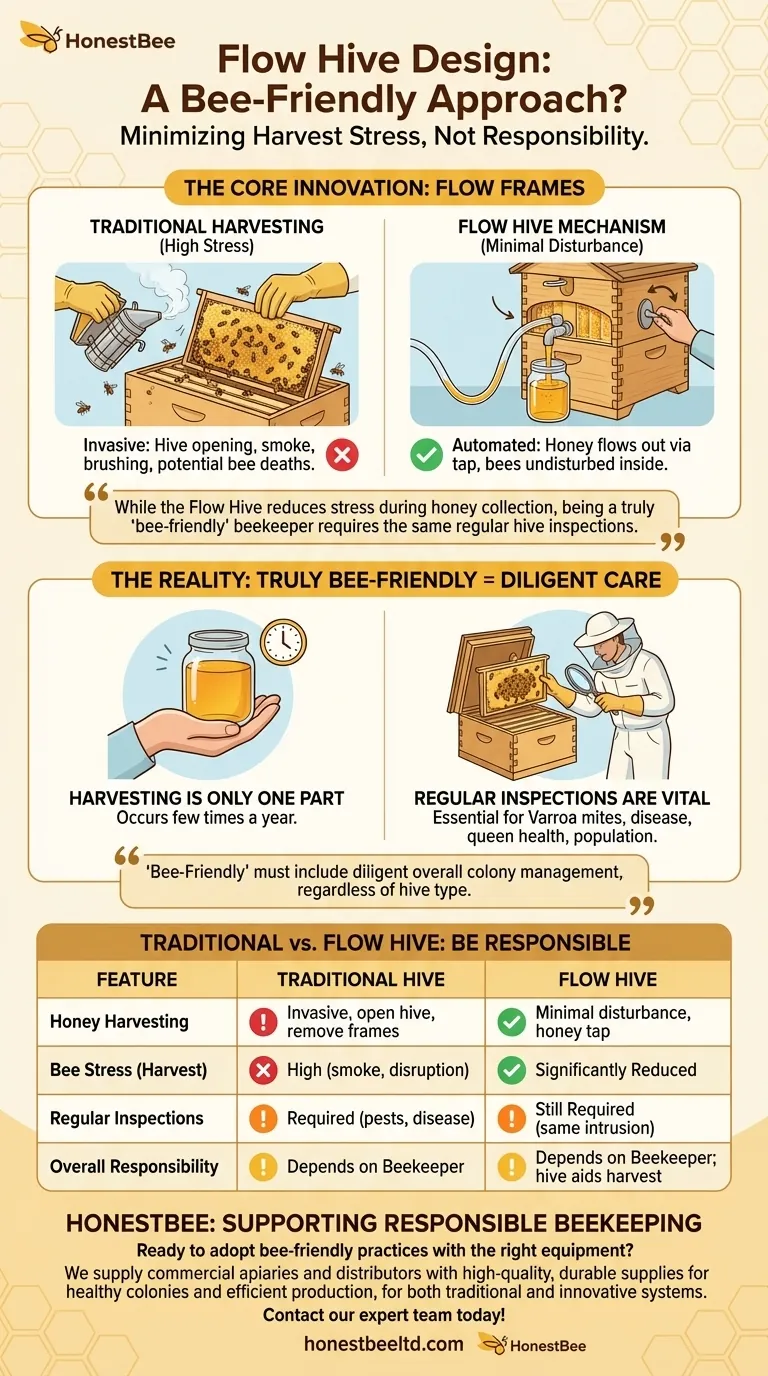At its core, the Flow Hive’s design promotes a bee-friendly approach by fundamentally changing the process of honey harvesting. Unlike traditional methods that require opening the hive and physically removing frames, the Flow Hive allows you to collect honey with minimal disturbance to the bees, thereby reducing stress on the colony.
While the Flow Hive’s innovative harvesting system significantly reduces stress on bees during honey collection, being a truly "bee-friendly" beekeeper still requires the same regular hive inspections and management as any traditional hive.

How the Flow Frame Minimizes Harvest-Day Stress
The primary innovation of the Flow Hive is not the hive box itself, but the specialized Flow Frames that sit inside it. Understanding this mechanism is key to understanding its bee-friendly claim.
The Traditional Harvesting Process
In a conventional beehive, harvesting honey is an invasive event. Beekeepers must open the hive, often using smoke to calm the bees, physically pull out each heavy frame, and brush the bees off. This process is stressful for the colony and can result in squashed bees.
The Flow Hive Harvesting Mechanism
The Flow Hive automates extraction directly within the hive. The frames are made of partially formed honeycomb cells which the bees complete with their own wax. Once the bees fill these cells with honey and cap them, the beekeeper inserts a tool and turns a lever.
This action splits the honeycomb cells vertically inside the frame, creating channels that allow the honey to flow down and out of the hive through a tube, all while the bees remain undisturbed on the surface of the comb.
The Direct Benefit for the Bees
This hands-off harvesting method is the cornerstone of the hive's bee-friendly reputation. It avoids the colony-wide disruption, defensive behavior, and accidental bee deaths that can occur during a traditional honey harvest.
Understanding the Misconceptions and Realities
The "bee-friendly" label is accurate for the harvesting process, but it can create a misleading impression that the hive requires less management overall. This is a critical point to understand for the health of your colony.
Harvesting is Only One Part of Beekeeping
Honey harvesting happens only a few times a year. The bulk of responsible beekeeping involves regular monitoring and management to ensure the colony is healthy and thriving.
The Necessity of Regular Hive Inspections
A Flow Hive does not eliminate the need for internal hive inspections. You must still open the hive periodically to check for critical health indicators.
These checks include looking for pests like Varroa mites, signs of disease, ensuring the queen is laying eggs properly, and checking the overall population strength. These inspections are just as intrusive as they are in a traditional hive.
"Bee-Friendly" Must Include Diligent Care
The Flow Hive's design makes one specific task—harvesting—less stressful for bees. However, a truly bee-friendly approach is defined by the beekeeper's overall diligence in managing colony health, which requires the same hands-on work regardless of the hive type.
Making the Right Choice for Your Goal
Deciding if a Flow Hive aligns with your beekeeping philosophy requires looking beyond the marketing and focusing on your goals.
- If your primary focus is reducing stress during the honey harvest: The Flow Hive is exceptionally well-designed for this specific purpose and is unmatched in minimizing disturbance during extraction.
- If your primary focus is a completely hands-off or "set-it-and-forget-it" experience: This is a misconception; a Flow Hive still requires regular, hands-on inspections to be managed responsibly and ensure the colony's long-term health.
Ultimately, a beekeeper's knowledge and attentiveness, not just the equipment, are what truly create a bee-friendly environment.
Summary Table:
| Feature | Traditional Hive | Flow Hive |
|---|---|---|
| Honey Harvesting | Invasive; requires opening hive, removing frames | Minimal disturbance; honey flows out via a tap |
| Bee Stress During Harvest | High (smoke, frame removal, potential bee deaths) | Significantly Reduced |
| Regular Hive Inspections | Required (for pests, disease, queen health) | Still Required (same level of intrusion) |
| Overall 'Bee-Friendly' Responsibility | Depends on beekeeper's management | Depends on beekeeper's management; hive aids only in harvest |
Ready to adopt bee-friendly practices with the right equipment? At HONESTBEE, we supply commercial apiaries and beekeeping equipment distributors with the high-quality, durable supplies needed for responsible hive management—whether you use traditional or innovative systems like the Flow Hive. Our wholesale-focused operations ensure you get the reliable gear for healthy colonies and efficient honey production. Contact our expert team today to discuss your apiary's needs!
Visual Guide

Related Products
- HONESTBEE Advanced Ergonomic Stainless Steel Hive Tool for Beekeeping
- Professional 3-Bar Frame Grip with Integrated Hive Tool
- Professional Dual-End Stainless Steel Hive Tool for Beekeeping
- Beehive Handle and Frame Rest Cutting Machine: Your Specialized Hive Machine
- Professional Galvanized Hive Strap with Secure Locking Buckle for Beekeeping
People Also Ask
- Why is it important to compare the progress of different hives? A Beekeeper's Key Diagnostic Tool
- How should beekeepers handle bees when using a hive tool? Master Calm, Deliberate Techniques
- What are the basic tools for beekeeping? Essential Starter Kit for Safe & Successful Hive Management
- What is the hole in a hive tool for? A Multi-Tool for Apiary Repairs and Maintenance
- What are some common uses of a hive tool? Essential Multi-Purpose Tool for Every Beekeeper



















